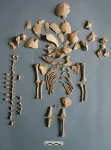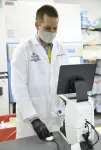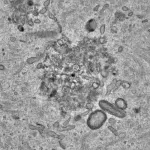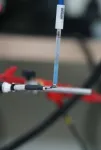(Press-News.org) By analysing ancient DNA, an international team of researchers have uncovered cases of chromosomal disorders, including what could be the first case of Edwards syndrome ever identified from prehistoric remains.
The team identified six cases of Down syndrome and one case of Edwards syndrome in human populations that were living in Spain, Bulgaria, Finland, and Greece from as long ago as 4,500 years before today.
The research indicated that these individuals were buried with care, and often with special grave goods, showing that they were appreciated as members of their ancient societies.
The global collaborative study, led by first author Dr Adam “Ben” Rohrlach of the University of Adelaide, and senior author Dr Kay Prüfer of the Max Planck Institute for Evolutionary Anthropology, involved screening DNA from approximately 10,000 ancient and pre-modern humans for evidence of autosomal trisomies, a condition where people carry an extra (third) copy of one of the first 22 chromosomes.
“Using a new statistical model, we screened the DNA extracted from human remains from the Mesolithic, Neolithic, Bronze and Iron Ages all the way up to the mid-1800s. We identified six cases of Down syndrome,” says Dr Rohrlach, a statistician from the University of Adelaide’s School of Mathematical Sciences.
“While we expected that people with Down syndrome certainly existed in the past, this is the first time we’ve been able to reliably detect cases in ancient remains, as they can’t be confidently diagnosed by looking at the skeletal remains alone.”
Down syndrome occurs when an individual carries an extra copy of chromosome 21. The researchers were able to find these six cases using a novel Bayesian approach to accurately and efficiently screen tens of thousands of ancient DNA samples.
“The statistical model identifies when an individual has approximately 50 per cent too much DNA that comes from one specific chromosome,” says Dr Patxuka de-Miguel-Ibáñez of the University of Alicante, and lead osteologist for the Spanish sites.
“We then compared the remains of the individuals with Down syndrome for common skeletal abnormalities such as irregular bone growth, or porosity of the skull bones, which may help to identify future cases of Down syndrome when ancient DNA can’t be recovered.”
The study also uncovered one case of Edwards syndrome, a rare condition caused by three copies of chromosome 18, that comes with far more severe symptoms than Down syndrome. The remains indicated severe abnormalities in bone growth, and an age of death of approximately 40 weeks gestation.
All of the cases were detected in perinatal or infant burials, but from different cultures and time periods.
“These individuals were buried according to either the standard practices of their time or were in some way treated specially. This indicates that they were acknowledged as members of their community and were not treated differently in death,” says Dr Rohrlach.
“Interestingly, we discovered the only case of Edwards syndrome, and a noticeable increase in cases of Down syndrome, in individuals from the Early Iron Age in Spain. The remains could not confirm that these babies survived to birth, but they were among the infants buried within homes at the settlement, or within other important buildings,” says Professor Roberto Risch, co-author and archaeologist from The Autonomous University of Barcelona.
“We don’t know why this happened, as most people were cremated during this time, but it appears as if they were purposefully choosing these infants for special burials.”
The research has been published in the journal Nature Communications and was part of a large collaborative project involving researchers from the University of Adelaide, including Dr Adam “Ben” Rohrlach, Dr Jonathan Tuke and Associate Professor Bastien Llamas, as well as researchers from across the world, including at the Max Planck Institute for Evolutionary Anthropology in Germany where the data was generated.
END
Ancient DNA reveals Down syndrome in past human societies
2024-02-20
ELSE PRESS RELEASES FROM THIS DATE:
Smiling is the secret to seeing happiness, new research reveals
2024-02-20
Smiling for just a split second makes people more likely to see happiness in expressionless faces, new University of Essex research has revealed.
The study led by Dr Sebastian Korb, from the Department of Psychology, shows that even a brief weak grin makes faces appear more joyful.
The pioneering experiment used electrical stimulation to spark smiles and was inspired by photographs made famous by Charles Darwin.
A painless current manipulated muscles momentarily into action – ...
Antil studying efficient algorithms for optimization problems with PDE constraints
2024-02-20
Harbir Antil, Professor, Mathematical Sciences; Director, Center for Mathematics and Artificial Intelligence (CMAI), received funding for the project: “Efficient Algorithms for Optimization Problems with PDE Constraints.”
Antil and his collaborators are examining generic optimization problems constrained by partial differential equations (PDEs) with or without uncertainty. In case of uncertainty, a risk-averse optimization framework will be developed. Decomposition and Compression techniques will be utilized to overcome the high computational costs. Several applications in various disciplines such ...
Age-related changes in fibroblast cells promote pancreatic cancer growth and spread
2024-02-20
Older people may be at greater risk of developing pancreatic cancer and have poorer prognoses because of age-related changes in cells in the pancreas called fibroblasts, according to research led by investigators from the Johns Hopkins Kimmel Cancer Center, the Johns Hopkins Bloomberg School of Public Health and the Bloomberg~Kimmel Institute for Cancer Immunotherapy.
The study, published online Feb. 8 in Cancer Research, provides clues as to why pancreatic cancer is more common and aggressive in older people. It may also help scientists develop ...
University of Birmingham signs pioneering collaboration agreement with Vital Energi
2024-02-20
The University of Birmingham has signed a collaboration agreement with Vital Energi to develop and commercialise a range of innovative thermal storage solutions, which will help accelerate decarbonisation within the heating and cooling sector.
The University and Vital Energi will work together over an initial four years to continue the development of thermal storage Intellectual Property (IP) with a view to bringing a number of products to market. As part of the agreement, the University has assigned several IP rights, including a number of patents, to Vital Energi.
The implementation of thermal energy storage is imperative to address the challenges posed ...
Oocytes outsmart toxic proteins to preserve long-term female fertility
2024-02-20
Oocytes are immature egg cells that develop in almost all female mammals before birth. The propagation of future generations depends on this finite reserve of cells surviving for many years without incurring damage. In mice, this can be a period of up to eighteen months, while in humans it can last almost half a century, the average time between birth and menopause. How the cells accomplish this remarkable feat of longevity has been a longstanding question.
Researchers at the Centre for Genomic ...
The Radcliffe Wave is waving
2024-02-20
A few years ago, astronomers uncovered one of the Milky Way’s greatest secrets: an enormous, wave-shaped chain of gaseous clouds in our sun’s backyard, giving birth to clusters of stars along the spiral arm of the galaxy we call home.
Naming this astonishing new structure the Radcliffe Wave, in honor of the Harvard Radcliffe Institute, where the undulation was originally discovered, the team now reports in Nature that the Radcliffe Wave not only looks like a wave, but also moves like one – oscillating through space-time much like “the wave” moving through a stadium full of fans.
Ralf Konietzka, the paper’s ...
Examining excess mortality associated with the pandemic for renters threatened with eviction
2024-02-20
About The Study: Housing instability, as measured by eviction filings, was associated with a significantly increased risk of death over the first 20 months of the COVID-19 pandemic in this study that included 282,000 renters who received an eviction filing. Eviction prevention efforts may have reduced excess mortality for renters during this period.
Authors: Nick Graetz, Ph.D., of Princeton University in Princeton, New Jersey, is the corresponding author.
To access the embargoed study: Visit ...
Fresh meat: New biosensor accurately and efficiently determines meat freshness
2024-02-20
WASHINGTON, Feb. 20, 2024 — The freshness of animal meat is an essential property determining its quality and safety. With advanced technology capable of preserving food for extended periods of time, meat can be shipped around the globe and consumed long after an animal dies. As global meat consumption rates increase, so too does the demand for effective measures for its age.
Despite the technological advances keeping meat fresh for as long as possible, certain aging processes are unavoidable. Adenosine triphosphate (ATP) ...
Large, diverse genetic study of glaucoma implicates vascular and cancer-related genes
2024-02-20
An international genetic study using multiancestry biobanks has identified novel genetic locations associated with primary open-angle glaucoma (POAG), the most common type of glaucoma and the leading cause of irreversible blindness globally. The findings, published Feb. 20 in Cell Reports Medicine, detail ancestry- and sex-specific genetic loci associated with POAG and implicate vascular and cancer-related genes in POAG risk.
“Although there has been significant progress using genome-wide association studies (GWAS) to explore the genetic pathophysiology of glaucoma in humans, there is still a lack of understanding of the underlying ...
HPV vaccination among young adults before and during the pandemic
2024-02-20
About The Study: The results of this study suggest that human papillomavirus (HPV) vaccination coverage among young adults did not increase during the COVID-19 pandemic compared with prior years. This finding likely reflects pandemic-related disruptions in initiating the HPV vaccine among young adults.
Authors: Kalyani Sonawane, Ph.D., of the Medical University of South Carolina in Charleston, is the corresponding author.
To access the embargoed study: Visit our For The Media website at this link https://media.jamanetwork.com/
(doi:10.1001/jamanetworkopen.2023.56875)
Editor’s Note: Please see the article for ...







